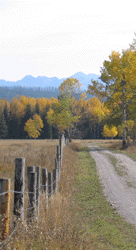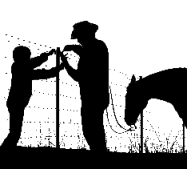|
Horse fencing as a Horse Lover's Gift?
|
What kind of a gift is that?

and finding enough gift wrap might be a problem.
To give credit where it's due, we'll mention the product we used
- only fair to do so; a testimonial really.
In that spirit we'll depart from "gift ideas for horse lovers" a bit
and offer some real life experience.
We decided what kind of horse fencing we needed through a process of elimination.
What we ended up with isn't necessarily the best solution for everyone,
just one that happened to work fine in our situation.
What were we looking for?
Horse fencing had to be safe and strong - fencing a horse couldn't just walk through if it had the notion, nor fencing that would break down under day-to-day use. We wanted fencing for our horses that wouldn't deteriorate over a short time and would be easy to maintain when maintenance was required. Mending a fence can be a pleasant pastime if you don't have to do too much of it.
Been there.
As we were going to do it ourselves, ease of construction was a big issue - we didn't want to spend all summer at it. Attractiveness was also important in our case - new house, woodsy setting. While we like white vinyl, wood rail seemed a better choice. Although we were going to build the fence ourselves, affordability was still somewhat of an issue.
So, when looking for a fencing solution you should consider -
- strength and durability
- maintainability
- safety
- attractiveness
- affordability*
- ease of construction**
*When figuring the costs, don't forget the gate(s)!
**Take ease of construction into account even if you're having a contractor do the work. If it turns out to be a difficult undertaking costs will rise.
The soil type and lay of the land can be a factor.
So, lets take a look at how we got to where we are -
Strength
- this generally isn't an issue for most kinds of horse fencing on the market. The choice really boils down to wood, vinyl, high tensile wire, ribbon and braid. Barbed wire is a definite no-no, please don't even give it a passing thought. In pasturing some of our horses temporarily behind barbed wire we had a bad experience like you sometimes read about - a cut up horse. Not worth the risk. So even thought the picture above showing man, boy, and horse repairing a fence is nice. It looks like barbed wire - maybe not so nice. Substitute braid and it's OK.
There are those who say that high-tensile wire is not much better. We've had no personal experience with high-tensile but are inclined to agree. So, I would narrow things down to wood, vinyl, ribbon or braid - using wire only for the purpose of electrification if required.
Maintainability
- vinyl is generally the easiest to maintain, no preservatives needed. For wood you'd better stick with treated wood, pressure treated for posts, or you'll spend lots of time down the road repairing and rebuilding. If you're building your own wood fencing using a sealant, count on reapplying it every year or so. In our experience braid has not required much maintenance, the same is likely true for ribbon.
Attractiveness
- For a long time we were set on building a post and rail fence as it would fit in perfectly with the rustic and woodsy setting we live in. For very large pastures and paddocks in open areas, white vinyl fencing is extremely attractive. We did not think ribbon or braid would be attractive at all. We were wrong!
We visited a small ranch a half-hours drive away where they had just installed braid on a one-acre area. It looked great.
Affordability
- The way the world works is this - most attractive, least affordable - least attractive, most affordable.
Ease of Construction
- This was the deciding factor for us. We were torn between the attractiveness of the rail fence vs. the relative high cost as compared to braid. Also we knew that building a rail fence would be the most work.
We didn't want to hire someone to drill or blast just so we could have a nice, even fence. So we went with braid.
Why Braid?
- Getting back to ease of construction, with braid we didn't need a post every 8 feet, one every 30 to 40 (even 50) feet would be just fine. The posts did not have to be evenly spaced although we tried to do that as much as we could for appearances sake. Even though there was a steep rise in a portion of the pasture, braid was no more difficult to work with there than on the level.
The really hard work involved peeling and treating the fir and larch posts, including the arch over the main gate. Of course we could have purchased very affordable pressure treated posts but that would have been no fun at all - although next time I think I'll go that route. I'm not getting any younger and my son isn't always around.
Oh yes, safety - the braid will not cut a horse and yields if the horse leans into it or runs into it. Of course being electrified the horses don't do that on purpose. It is definitely "horse friendly".
The particular brand of braid (and fittings) we used was Electrobraid. You can visit their very informative website at www.electrobraid.com and get all the information you really need to use their product. They have a video that does an excellent job of showing what is involved in putting in some fencing. Looks easy and we found that to be the case.
P.S. While our posts were free - trees from our own property - we could have gone with steel T-bar posts except at the ends and corners.
Installation would have been easier but the wood posts make the braid much more attractive and give greater solidity to the overall fence. Just looks a lot better. We even used trees as "corner posts" in a couple of places.

